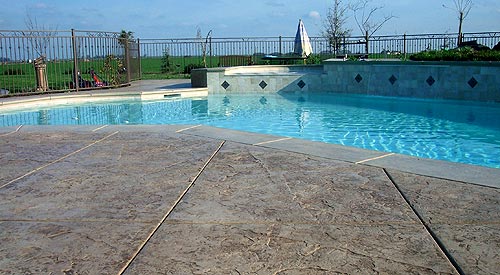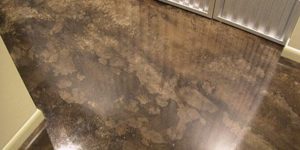
I had looked forward to this day for a long time. I’m guessing it must have been 10 or 12 years ago. This would be the morning my concrete crew started the decorative concrete work for one of the most successful entrepreneurs ever to come from my area in the eastern San Joaquin Valley of California. His name was Leonard Whitney and he had masterminded what is today one of the largest grocery store franchises in the business. What a great opportunity for me to ask questions and receive useful information to leverage my contracting company to a higher level, from someone who obviously held the keys to success.
After I rushed through color samples and pattern choices to the point where Mr. Whitney felt comfortable with my abilities, I asked the question I had been dying to ask: “How? How, Mr. Whitney, did you manage to build such a successful and respectable business?” His reply was shorter than I expected. “The grocery business is all I know, so it is all I do,” said my client.
Inside, I’m thinking, “This is where he clubs me over the head with the hard work, integrity, never quitting, blah, blah, blah,” but he simply turns and walks off. A man closer to 80 than 70, with nothing to prove and no shortcuts: another lesson learned.
The decorative concrete industry is in transition and has been for some time. Yes, this is an article on transitioning your business into the decorative side, and I will give several useful tips on doing just this. But please remember, there are no shortcuts. These tips will help you segue into decorative, but the real key is perseverance.
The decorative industry is made up of two types. The first is the scraped-knuckle, dirt-in-the-eye, old-school contractor who has been doing this for a generation or three. The other type is artistic, free, creative and broke. Somewhere in the middle of these two types is the most powerful combination ever to enter the decorative market. Harness the best of both types and the result is nothing short of incredible. Regardless of what type you are, here’s the bottom line: Winners do what losers won’t. All of the creativity in the world will do little good without the discipline and organization it takes to run a business. Enough said, let’s get you started in the decorative side of the concrete business.
Step One: Give away your first decorative jobs
Take the pressure off yourself and realize that there are many steps you and your crew must learn in order to successfully complete a decorative project. I know there are good seminars and deminars available and I recommend attending one or two for the base knowledge you will need. But make no mistake about it — the real training will come on the job by learning to deal with the day-to-day adversities that every project presents. So to start with, turn one of your projects into something decorative at no additional cost. This is how I started. I did it with stamped concrete, but it makes little difference what type of decorative work you’re developing.
Make it very clear to your client they are receiving a huge discount so you are creating a win-win situation for both parties. Do not expect your clients to rant and rave about how great your work looks when completed. The project is not going to be perfect and that is understandable. Also, it is human nature to show less appreciation for things unpaid for. You are simply trying to develop experience as well as test the market in your area. Get good pictures and ask for a one- or two-line testimonial when the project is completed.
Confidence comes from experience and experience comes at a price. Consider this a paid education and a time to ask if this is a direction you want to take your company. I remember one time a gentleman realizing, after the fifth on-the-job training day, what he didn’t want to do for a living. He hadn’t realized how complex or labor-intensive decorative work could be. It’s better to realize this and redirect early on rather than do it after you have invested more money. Complete two or three discounted projects and closely evaluate each project on ways to improve.
Step Two: Don’t quit your day job
It took me years to evolve into a full-service decorative company. My crew would pour structural concrete and mix in stamped projects as the market developed. I noticed we would forget steps because of the time-lapse between projects. After working on structural concrete, my enclosed trailer would be missing tools or supplies needed for a successful decorative project. It is difficult for a crew to switch gears from day-to-day and it requires strong organization to pull it off. These are the growing pains necessary to develop into something better, regardless if it’s decorative concrete, acting, or sports.
Most of us have house payments and other obligations that require thoughtful expansion of our companies. Develop at a safe pace without jeopardizing the things you and your family have worked hard for. Phase out traditional jobs and replace with decorative ones. Develop the market in your own way. You should be spending a little money to market your new service. Put decorative pictures and a testimonial letter or two into a portfolio binder and take it everywhere. Change your business cards to help describe your new service and maybe include a decorative project as the background. Develop job-site signs so potential customers can put a name to a project. Develop a logo and put it on everything. Send out a press release talking about your new services and certifications. The local papers love this stuff and they are very effective for new work. Keep the press release short and to the point and be sure to leave a contact number.
Step Three: Yellow Pages or Web site?
I read two articles last month that declared Yellow Page ads obsolete and outdated. Well, before we pull the plug on Ma Bell, let me say this: Yellow Page ads still work in most markets. Some markets are more technically savvy then others and we must market accordingly. More traditional areas are more likely to refer to the Yellow Pages then the Web. I’m sure this is slowly changing, but I would closely evaluate my market to get the best bang for my buck. Another consideration is the baby boomers and how they look for new services. Start with a Yellow Page ad and use colorful pictures to describe your service. Keep the wording to a minimum — decorative concrete is visual. Next, develop an open-ended Web site. This will allow you to add and change it as you grow and redirect. Link to other sites related to the decorative industry. Talk to Mark Dixon at Concrete Decor for more ideas on building a great Web site.
Final word
Every step and idea mentioned above is exactly the way I built my business. I’m not saying it’s the only way, but it is proven. Give your own twist and flavor and monitor the outcome. One other tip to try is to use publications as sales and marketing aids. High-gloss magazines are very effective and will help develop a client base among builders, architects, landscapers, and designers. Talk to Concrete Decor about a direct mail marketing approach (subscription sponsorship) and how they can help you build your business. Let me know how it goes.
















